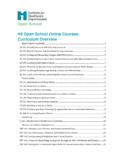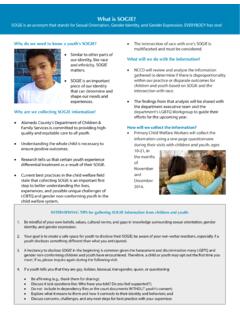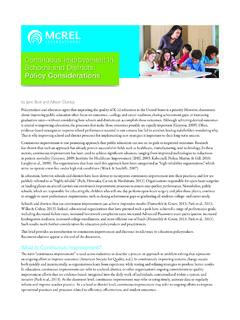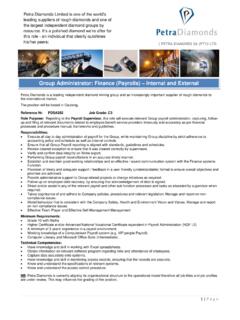Transcription of HUD MULTIFAMILY OCCUPANCY HANDBOOK
1 HUD HANDBOOK : OCCUPANCY REQUIREMENTS OF SUBSIDIZED MULTIFAMILY HOUSING PROGRAMS SUMMARY FOR TENANTS October 2003 TABLE OF CONTENTS Purpose of the HANDBOOK and This 1 I. 1 II. Eligibility to Live in HUD-subsidized 3 III. Applying to Become a Tenant in HUD-subsidized 6 IV. Applicant/Tenant Civil Rights and Responsibilities.. 7 V. How are Monthly Rents Calculated?.. 9 VI. Lease 11 VII. Ongoing Tenant 13 VIII. Rent Changes and Unit 15 IX. Other Sources of 15 HUD MULTIFAMILY OCCUPANCY HANDBOOK October 2003 Summary for Tenants i PURPOSE OF HUD HANDBOOK REV-1 AND THIS SUMMARY HUD-subsidized MULTIFAMILY properties represent an important and valuable resource in addressing the nation s affordable housing needs. The successful delivery of this housing resource to the people who need it depends on effective OCCUPANCY policies and procedures. HUD s OCCUPANCY requirements and procedures ensure that eligible applicants are selected for OCCUPANCY , that tenants receive the proper level of assistance, and that tenants are treated fairly and consistently.
2 HUD HANDBOOK Rev-1, OCCUPANCY Requirements of Subsidized MULTIFAMILY Housing Programs (also referred to in this summary as the MULTIFAMILY OCCUPANCY HANDBOOK ) describes OCCUPANCY -related program requirements and the responsibilities of HUD, Contract Administrators, property owners, property managers, and tenants. This summary is provided to help applicants to and tenants of HUD-subsidized properties. It highlights the key OCCUPANCY requirements in HUD HANDBOOK Rev-1 that affect applicants and tenants, and provides references to the HANDBOOK for each topic. This summary presents the key topics using a Question and Answer format. I. INTRODUCTION This section describes: What HUD means by the term OCCUPANCY requirements; The key topics covered in this summary; What types of properties are considered HUD-subsidized properties; and What information is available to help answer questions about other topics regarding HUD-subsidized properties. Q: What does HUD mean by the term OCCUPANCY Requirements ?
3 A: The Department of Housing and Urban Development (HUD) provides a financial subsidy to the property in which you are applying to live or are currently a tenant. These properties are designed to serve eligible lower income families and this subsidy helps keep the rents in these properties affordable. When the term OCCUPANCY requirements is used in this summary and HUD HANDBOOK Rev-1, it refers to program requirements that help to ensure: Eligible applicants are selected to live in these properties. Tenants receive the proper level of housing assistance under the requirements of the program providing subsidy to the property. Tenants are treated equitably and fairly in accordance with program requirements. HUD MULTIFAMILY OCCUPANCY HANDBOOK October 2003 Summary for Tenants 1 Q: What are the key topics discussed in this summary? A: The key topics from HUD HANDBOOK Rev-1 that are highlighted in this Summary include: Eligibility requirements for living in HUD-subsidized properties; Applying to become a tenant in HUD-subsidized properties; Applicant/tenant civil rights and responsibilities; How monthly rent payments are calculated; Lease terms; Ongoing tenant responsibilities for annual and interim income recertifications; Rent changes and unit transfers; and Other sources of information.
4 Q: What types of properties are considered HUD-subsidized properties? A: HUD-subsidized properties are privately-owned, MULTIFAMILY rental properties that receive a mortgage interest subsidy, project-based rental assistance, or both through one or more of the following federal housing programs administered by HUD. Section 221(d)(3) Below-Market Interest Rate (BMIR); Section 236; Rental Assistance Payment (RAP); Rent Supplement; Section 8 Project Based Assistance, which includes: New Construction properties; State Agency Financed properties; Substantial Rehabilitation properties; Section 202 properties with Section 8 assistance; RHS Section 515 properties with Section 8 assistance; Loan Management Set-Aside (LMSA) assistance; Property Disposition Set-Aside (PDSA) assistance; Section 202 without assistance (income limits only); Section 202 with 162 Assistance Project Assistance Contracts (PACs); Section 202 with Project Rental Assistance Contracts (PRACs); and Section 811 with Project Rental Assistance Contracts (PRACs).
5 These properties provide affordable rental units to lower income families who meet the eligibility requirements of the program(s) providing the subsidy. For information on the programs listed above, please refer to HUD HANDBOOK Rev-1, Chapter 1, paragraph 1-3. HUD MULTIFAMILY OCCUPANCY HANDBOOK October 2003 Summary for Tenants 2 Families applying to live in HUD-subsidized housing (and tenants already living in HUD-subsidized properties) can find out the type of federal program providing the subsidy to the property by asking the owner or manager of the property, or by calling the local HUD Field Office (see Section IX Other Information Sources in this Summary for information about how to locate HUD Field Offices). Q: What information is available to help answer questions about other topics regarding HUD-subsidized properties? A: HUD HANDBOOK Rev-1 does not address program requirements regarding topics beyond OCCUPANCY , such as the physical condition of a property, unit maintenance, or requests from property owners for rent increases.
6 For information about these and other related topics, please refer to HUD HANDBOOK , MULTIFAMILY Asset Management and Project Servicing. For a listing of HUD informational resources about further topics, please refer to Section IX Other Information Sources in this Summary, or HUD HANDBOOK Rev-1, Chapter 1, paragraph 1-7. II. ELIGIBILITY TO LIVE IN HUD-SUBSIDIZED PROPERTIES This section describes: General eligibility requirements; Income limits for different HUD programs; How income limits vary by family size; Restriction on rental assistance to noncitizens; Differences in eligibility requirements across properties under the same program; OCCUPANCY standards; and Information that applicants have to provide owners/managers to determine their eligibility to live in the property. Q: What are the eligibility requirements for HUD-subsidized MULTIFAMILY housing? A: Applicants and tenants must meet the following requirements to be eligible for housing assistance.
7 The family must report the annual income of family members, including assets, as required under program rules. (See Section V of this summary.) The family s annual income must not exceed program income limits. All information reported by the family is subject to verification. Applicants must disclose social security numbers for all family members over the age of 6 and provide proof of the numbers reported. All adults in each applicant family must sign an Authorization for Release of Information prior to receiving assistance and annually thereafter. An applicant must agree to pay the rent required by the program under which the applicant will receive assistance. The unit for which the family is applying must be the family s only residence. HUD MULTIFAMILY OCCUPANCY HANDBOOK October 2003 Summary for Tenants 3 Only citizens or eligible noncitizens may receive assistance under Section 8, Section 236, Rent Supplement, Rental Assistance Payment (RAP), and Section 202/8 programs.
8 Some MULTIFAMILY housing programs may establish additional OCCUPANCY restrictions. For more specific information about eligibility requirements, please refer to HUD HANDBOOK Rev-1, Chapter 3, Section 1. Q: What are income limits and how do they differ among HUD programs? A: HUD program requirements establish the income limits that are used to help determine whether applicants for HUD-subsidized housing are eligible for admission. HUD revises these income limits annually to ensure that they reflect increases or decreases in area income levels. There are four types of income limits: BMIR income limit - The annual household income equal to 95% of the median income for households in the area in which the property is located. Low-income limit - The annual household income equal to 80% of the median income for households in the area in which the property is located. Very low-income limit - The annual household income equal to 50% of the median income for households in the area in which the property is located.
9 Extremely low-income limit - The annual household income equal to 30% of the median income for households in the area in which the property is located. HUD program requirements specify the income limits used by each program. For additional information on income limits and the specific limits used by individual HUD programs, please refer to HUD HANDBOOK Rev-1, Chapter 3, paragraph 3-6. Q: How do income limits vary by family size? A: HUD establishes income limits based upon family size and the income of the family. The greater the number of family members that will occupy a unit, the higher the income limit used to determine a family s eligibility. For additional information on how family size affects the income limits used to determine eligibility, please refer to HUD HANDBOOK Rev-1, Chapter 3, paragraph 3-6 E, and Figure 3-3. Q: Are noncitizens eligible for rental assistance? A: No (except in certain properties). By law, only citizens and noncitizens that have eligible immigration status may receive rental assistance.
10 For more information on the restriction regarding rental assistance to noncitizens, please refer to HUD HANDBOOK Rev-1, Chapter 3, paragraph 3-12. NOTE: The restriction prohibiting rental assistance to noncitizens does not apply to properties receiving the following four types of subsidy: Section 221(d)(3) BMIR, Section 202 PAC, Section 202 PRAC, and Section 811 PRAC. HUD MULTIFAMILY OCCUPANCY HANDBOOK October 2003 Summary for Tenants 4 Q: Are there differences in the eligibility requirements across properties receiving assistance from a given program? A: Yes. So far, this section has described applicant eligibility to participate in HUD programs. However, HUD program requirements allow some limited differences in eligibility criteria within a program to help achieve the goals established for that program. For example, some or all of the units in a property might be designated for specific family types, such as those who are elderly or disabled.













